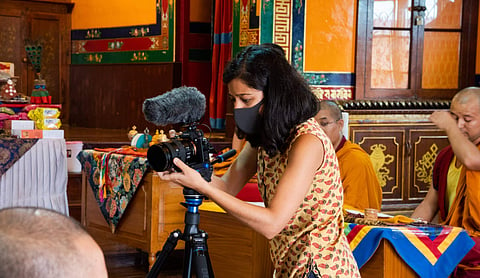

Munmun Dhalaria, an independent filmmaker and National Geographic storyteller, has been documenting stories of hope and resilience in both the Indian and Tibetan populations that reside in Dharamshala, Himachal Pradesh, which is also her hometown. Since the nationwide lockdown, Munmun has been filming the COVID-19 response from the western Himalayas, looking at the ways in which local communities, NGOs and the government are tackling the onslaught of the Novel Coronavirus.
Before the pandemic hit, the young filmmaker had been focusing more on wildlife conservation and environmental films and she tells us she will return to those soon. "During a global pandemic, I feel like my services as a storyteller are better served in highlighting inspiring individuals and their struggles of dealing with the current scenario of a tanking economy, and exacerbated public health crisis and a completely uncalled for military stand-off at the India-Tibet border," Munmun tells us.
Munmun is editing two documentaries currently — one is called the COVID response- A Himalayan story, focusing on how the people in the hills are dealing with the crisis and the other one is Lockdown-in-Exile, which is looking at how the Tibetan refugee community has dealt with the Coronavirus. "Throughout the pandemic, I have filmed frontline workers — doctors, nurses and administrative staff as they try to avoid having a community spread of this virus in a remote Himalayan state. I have also documented the current economic downfall by speaking to individuals who have lost their jobs, or business owners who have had to lay-off their entire staff. Being an agrarian state that so highly depends on tourism for employment, Himachal has had many challenges and will continue to adapt in the coming years. During the national lockdown, community radio like Radio Gunjan has been the bridge between various government departments and the people. They have worked relentlessly throughout the pandemic, bringing real-time information to the locals," adds Munmun.
Munmun has a degree in media studies from IP College, Delhi University and completed her MA in Media and Cultural Studies from TISS, Mumbai. She talks to us about her shooting experience during a pandemic when everything was under lockdown. "I waited to film until the Himachal curfew was lifted as I wanted to understand the situation a little better before venturing outdoors with a crew. I chose to film stories which were within a driving distance from my house as I wanted to take all the necessary precautions while venturing into vulnerable communities - monasteries and slums included. We wore masks and gloves and sanitised our equipment after each location. Since the filming was supported by a National Geographic Emergency Fund for Journalists, I had access to well-researched international protocols on covering this pandemic safely," she tells us.
The resilience of Tibetan people is the subject of her second documentary Lockdown-in- Exile and it talks about them as they navigate this pandemic with the help of their government-in-exile, headquartered in Dharamshala. "In July, I met Tenzin Tsundue, a poet and activist who has been the voice of Tibet’s freedom movement for the international media. He has consistently fought for an independent Tibet for decades, and appeared on numerous prime-time shows throughout the lockdown, taking his message both to the streets and online," adds Munmun. She tells us that she was also inspired by the leadership of Sikyong (or the Tibetan President) Lobsang Sangay, who explained to her how Tibetan settlements throughout India are quarantining anyone who travels in and out of them. "This was essential to stop community spread as many Tibetan children and older people reside in hostels and monasteries- which are places that make social-distancing impossible. As a community, their focus on online education and mental health during this time of crisis has also been commendable," she says.
Speaking about some of her memorable experiences while shooting during the pandemic and meeting new people, Munmun specially mentions the activists she met who have been relentlessly working on the ground to help people in distress during these testing times. "In June, I got a glimpse into India’s horrifying migrant crisis as I filmed Poonam and Krishna Munda, daily wage labourers from Jharkhand, who were on the last Shramik special train home. Individuals and civil society organisations became a bridge between stranded migrants who wanted to return home and the local government. Aditi Vajpeyi, a young environmentalist at Himdhara collective, was a huge source of inspiration to me, as she worked round the clock, disseminating information regarding e-passes to people who didn’t have access to technology. She continues to fight for labour rights as they are currently being diluted across India," she adds.
